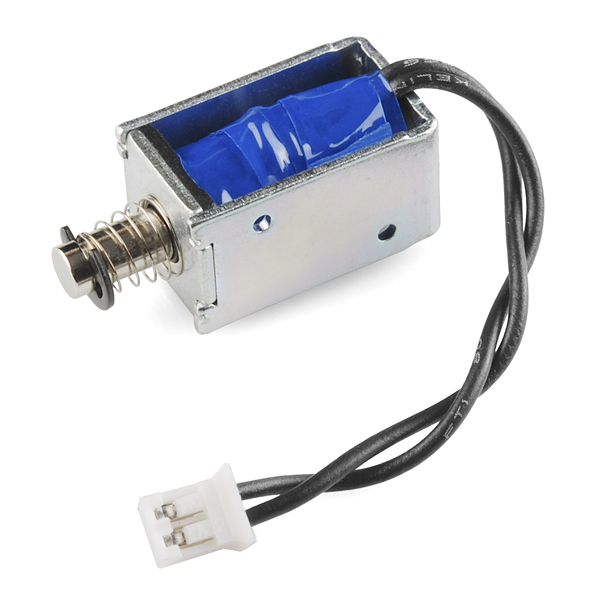Solenoids are basically
electromagnets: they are made of a big coil of copper wire with an armature (a
slug of metal) in the middle. When the coil is energized, the slug is pulled
into the center of the coil. This makes the solenoid able to pull from one end.
This solenoid in particular
is nice and strong, and has a slug with a slanted cut and a good mounting
bracket. It's basically an electronic lock, designed for a basic cabinet or
safe or door. Normally the lock is active so you can't open the door because
the solenoid slug is in the way. It does not use any power in this state. When
9-12VDC is applied, the slug pulls in so it doesn't stick out anymore and the
door can be opened.
The solenoids come with the
slanted slug as shown above, but you can open it with the two Phillips-head
screws and turn it around so its rotated 90, 180 or 270 degrees so that it
matches the door you want to use it with.
You will need a fairly good power supply to
drive a solenoid, as a lot of current will rush into the solenoid to charge up
the electro-magnet, about 500mA, so don't try to power it with a 9V battery!
TECHNICAL DETAILS
- 24 DC operation (you can use 9-24 DC volts, but lower voltage results in weaker/slower operation)
- Push or pull type with 5.5 mm throw
- DC coil resistance: 100 ohms
- 5 Newton starting force (24VDC)
- 1.4 oz / 39 grams
When
an electrical current is passed through the coils windings, it behaves like an
electromagnet and the plunger, which is located inside the coil, is attracted
towards the centre of the coil by the magnetic flux setup within the coils
body, which in turn compresses a small spring attached to one end of the
plunger. The force and speed of the plungers movement is determined by the
strength of the magnetic flux generated within the coil.
When
the supply current is turned “OFF” (de-energised) the electromagnetic field
generated previously by the coil collapses and the energy stored in the
compressed spring forces the plunger back out to its original rest position.
This back and forth movement of the plunger is known as the solenoids “Stroke”,
in other words the maximum distance the plunger can travel in either an “IN” or
an “OUT” direction, for example, 0 – 30mm.
Linear
solenoids are useful in many applications that require an open or closed (in or
out) type motion such as electronically activated door locks, pneumatic or
hydraulic control valves, robotics, automotive engine management, irrigation
valves to water the garden and even the “Ding-Dong” door bell has one. They are
available as open frame, closed frame or sealed tubular types.



